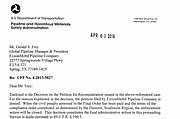A federal regulatory agency on Friday upheld its findings, including a $2.63 million fine, against Exxon Mobil Pipeline Co. as a result of an oil spill in a Mayflower neighborhood just over three years ago.
Even so, the case may not be over. Exxon Mobil spokesman Ashley Smith Alemayehu said the company, a subsidiary of Exxon Mobil Corp., was evaluating it options, including a possible court appeal.
One major concern for the oil giant appears to be that part of a compliance order would apply to all of the company's older, pre-1970 electric-resistance welded pipe, not just that on the Pegasus pipeline.
The Pegasus pipeline cracked open March 29, 2013, between two houses in Mayflower's Northwoods subdivision, spilling tens of thousands of gallons of heavy crude into the neighborhood, drainage ditches and a cove of Lake Conway.
Only a 211-mile section of the roughly 850-mile-long pipeline, running from Patoka, Ill., to Nederland, Texas, has resumed service since the accident. Twenty-two houses were evacuated, some for months. Some residents never moved back, and three of the homes were demolished. Exxon Mobil has told federal authorities that the accident caused $57 million in property damages.
"The pipeline remains down, and at this time we do not have plans to submit a revised remedial work plan," Alemayehu said in an email.
According to the order by the federal Pipeline and Hazardous Materials Safety Administration, Exxon Mobil had argued that the agency should withdraw its compliance order "because the Company committed no violations."
"In the alternative, [Exxon Mobil Pipeline Co.] argued the Compliance Order is overbroad and an abuse of discretion because some provisions apply to all pre-1970 ERW [electric resistance welded] pipe subject to the Company's [integrity management plan], not just the Pegasus Pipeline."
The agency countered that it has the authority to issue orders directing compliance with integrity-management regulations. Further, it said, "The Final Order also found the corrective actions were appropriately tailored to ensure [Exxon Mobil] considers the risk of seam failures on its pre-1970 [electric resistance welded] pipe covered by the regulation."
Jeffrey Wiese, the government's associate administrator for pipeline safety, notified Exxon Mobil of the decision in a letter Friday.
"When the civil penalty assessed in the Final Order has been paid and the terms of the compliance order completed, as determined by the Director, Southwest Region, the enforcement action will be closed. This decision constitutes the final administrative action in this proceeding," Wiese told Gerald Frey, global pipeline manager and president for Exxon Mobil Pipeline Co.
In November 2013, the Pipeline and Hazardous Materials Safety Administration notified Exxon Mobil that the oil giant had committed nine violations of federal safety regulations in connection with the accident. The agency proposed a civil penalty of $2,659,200 and corrective action but later lowered that to $2,630,400 -- the sum upheld Friday.
Exxon Mobil appealed that decision under a safety-agency process. When that didn't go as well as the oil giant wanted, it appealed again, asking for reconsideration. Any other appeal now would have to be to a court.
Upheld findings included:
• The oil company failed to establish a continual assessment schedule for the Pegasus based on all of the risk factors. Exxon Mobil should have considered the Pegasus, built in 1947-48, susceptible to seam failure since the type of pipe used was known to have an increased risk of seam failure, in part because of manufacturing defects such as hook cracks. That is exactly what Exxon Mobil has said caused the pipeline's rupture in Mayflower.
• Exxon Mobil failed to perform an integrity assessment of the Pegasus pipeline at an interval not to exceed five years or 68 months using a method that could assess seam integrity.
• The company failed to notify the federal Office of Pipeline Safety that it planned to exceed the five-year interval for performing a seam integrity assessment.
• Exxon Mobil failed to prioritize its pipeline segments properly for reassessment when it performed a seam integrity assessment of the Patoka-to-Conway segment in 2010 but waited until 2012-13 to do the same check on the Conway-to-Corsicana, Texas, segment. It was in that latter segment that the Mayflower accident occurred.
• Exxon Mobil failed to reduce operating pressure temporarily or to shut down its pipeline until it completed certain repairs.
• The company failed to obtain information about its pipeline conduction no later than 180 days after an integrity assessment, unless that period was impracticable.
• Exxon Mobil failed to follow its own procedures for identifying changed conditions and its procedures for determining if changes required updating the risk assessment.
• The company failed to follow procedures associated with its integrity management program when it did not follow instructions for using its threat identification and risk assessment program.
• The company didn't implement and follow provisions of its integrity management plan when it merged four testable pipeline segments into two.
State Desk on 04/02/2016
